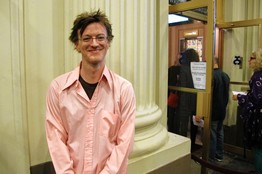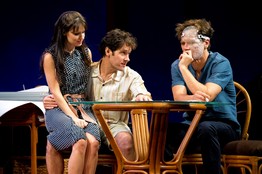http://online.wsj.com/article/SB10000872396390444180004578016431210218750.html?mod=googlenews_wsj
By LIZZIE SIMON
Each week in Curtain Raisers, we invite a local theater artist to attend a show of his or her choosing and discuss the results. Last Thursday, the projection designer Jeff Sugg opted to see Craig Wright’s “Grace” at the Cort Theatre on 48th Street. Mr. Sugg’s Broadway credits include “33 Variations” and “Bring it On: The Musical.” He is a co-founding member, with Cynthia Hopkins and Jim Findlay, of Accinosco, whose next show, a climate-crisis musical called “This Clement World,” will have its premiere at St. Ann’s Warehouse in February. Mr. Sugg is currently working on the musical “Fun Home,” which will run at the Public Theater from Oct. 17 to Nov. 4.
Lizzie Simon for The Wall Street JournalJeff Sugg
“Every show, if you’re lucky, there’s three seconds of an emotional experience which becomes a spiritual experience because you’re having it with a room full of people having it,” Mr. Sugg said.
At Thursday night’s preview of “Grace” there had been not one but a bounty of such experiences. “This,” he said, “is why we do theater.”
The play follows a devout Christian couple, Sara and Steve (Kate Arrington and Paul Rudd), who have moved from Minnesota to Florida to pursue a business opportunity involving a chain of Jesus-inflected hotels. Sara feels out of sync and lonely and befriends their neighbor, Sam (Michael Shannon), a NASA engineer who has just survived a tragic car accident.
“It’s about faith—losing faith, finding faith,” Mr. Sugg said. “It’s really hard to write about that and do it well.”
At the start of the play the characters seem neatly divided between believers and the non-believers. Steve and Sara profess a breathless, blind faith, one that can prevent harm and beget real-estate deals. Sam, science-minded and recently traumatized, has no belief in a benevolent higher power, nor any patience for people who do. The exterminator who visits both apartments (Ed Asner), himself a war-crimes survivor, pretty much feels the same.
That any of these characters might switch sides during the course of the drama is not exactly a surprise—characters transform in the theater. But the miracle in “Grace,” as Mr. Sugg saw it, is that the audience is drawn from an academic questioning of whether there is any grace in the world to an unlikely, awestruck sense that there is. “For everybody in the audience who is laughing along in the beginning in all their atheist whatever, it’s like, ‘Bam, sorry dude, we got you.'”
If “Grace” hinges on one’s personal investment in the spiritual realm, on a parallel level the show bolstered Mr. Sugg’s faith in his profession. “On my worst days, I bemoan the fact that I’m not doing anything for society,” he said. “It’s easy to forget that theater can change the world. Or at least it can change people a little.”
Joan Marcus Mr. Sugg attended a performance of ‘Grace,’ above with Kate Arrington, Paul Rudd and Michael Shannon
“Grace” is a straight play with no projections, which Mr. Sugg, a projection designer, opted to see on account of that very fact. “I just did “Bring It On,” which is a big fancy musical,” he said. “I wanted to see something that was less visually extravagant and more bare.”
His work with projections has ranged from displaying super-titles, as he did in “Tribes,” to incorporating video, as he will with “This Clement World,” to providing setting, as in “Bring It On.”
“At its best, projection adds its own layer of story without being overly visually complicated,” he said. “There’s a certain amount of engineering involved, but in an ideal world you’re putting something into the story alchemically, as opposed to just using a bunch of screens.”
Typically, when he sees the work of other projection designers at the theater, he becomes a judge of aesthetics and technicality. “I’m thinking, ‘That sucks, that’s good, that’s a little off.'”
But in the absence of projections, “What my mind is able to do is freely imagine. There’s no job for me here.”
“Grace” may have lacked projections, but its set design, by Beowulf Boritt, was by no means old fashioned. On the set, both apartments overlap as one, with the furniture rotating on an inner ring in one direction and the apartments’ doors and windows rotating on an outside ring in the opposite direction. Behind them, clouds in the sky, likely painted on fabric, drifted continuously on a track. Dizzy yet? That’s the point. The impact can be disorienting and, as Mr. Sugg suggested, in complete service to the play and the performers.
He described the overall experience as “an ego attenuator. Here’s a playwright who wrote a beautiful play that doesn’t need projections to tell the story,” he said. “It just reminds me that the art form is much bigger than my contribution to it.”
A version of this article appeared September 25, 2012, on page A26 in the U.S. edition of The Wall Street Journal, with the headline: Have Faith in the Theater.

